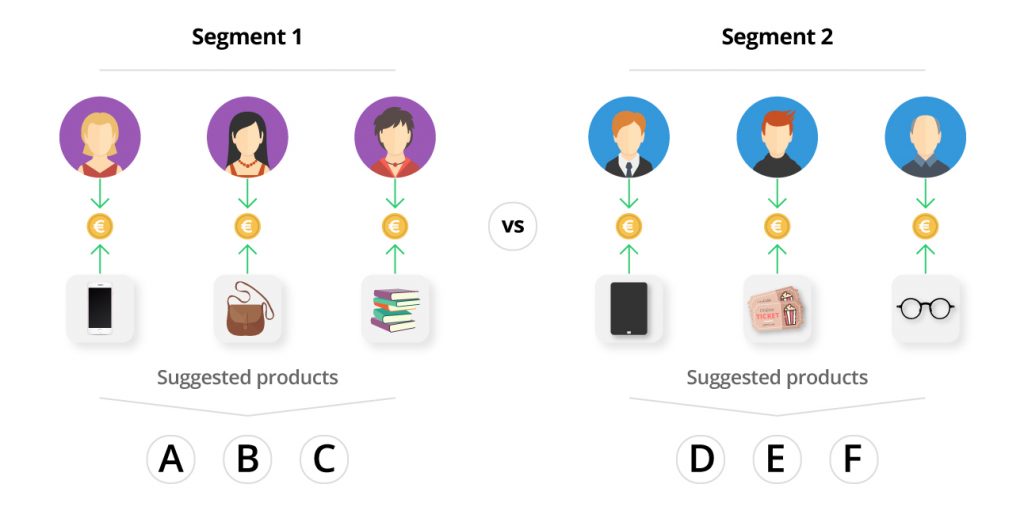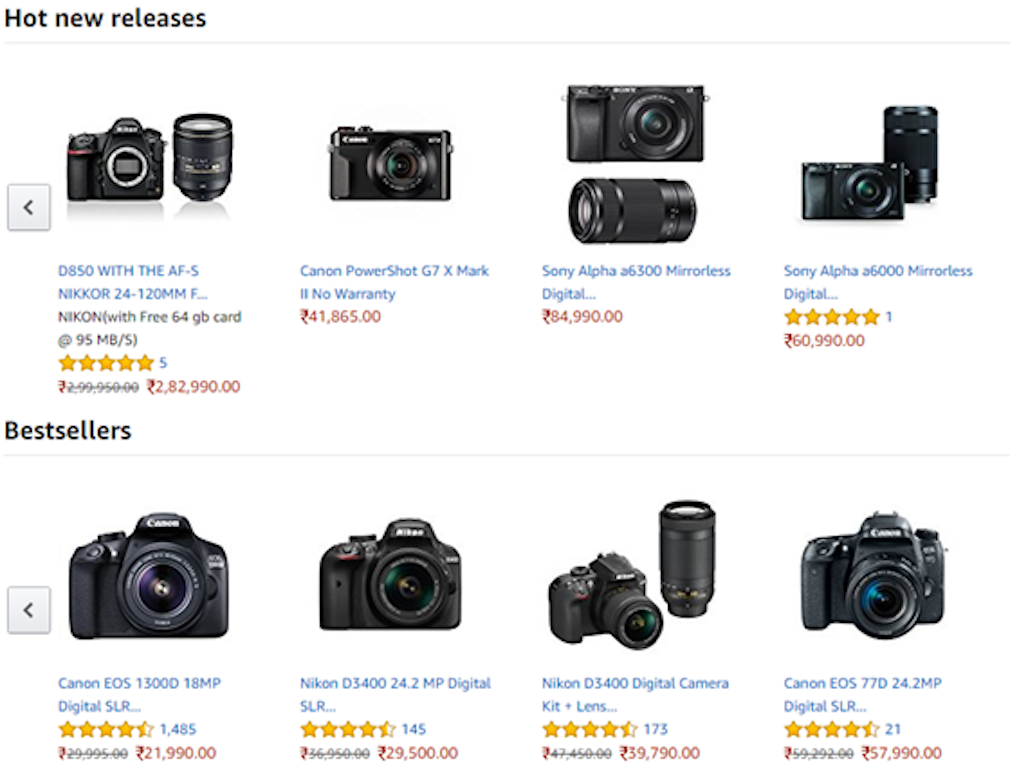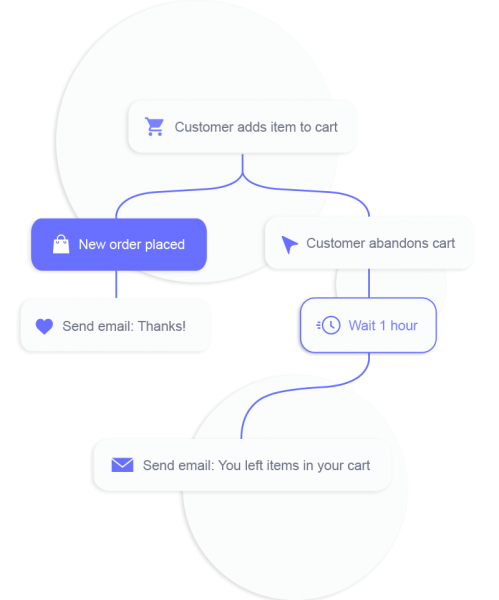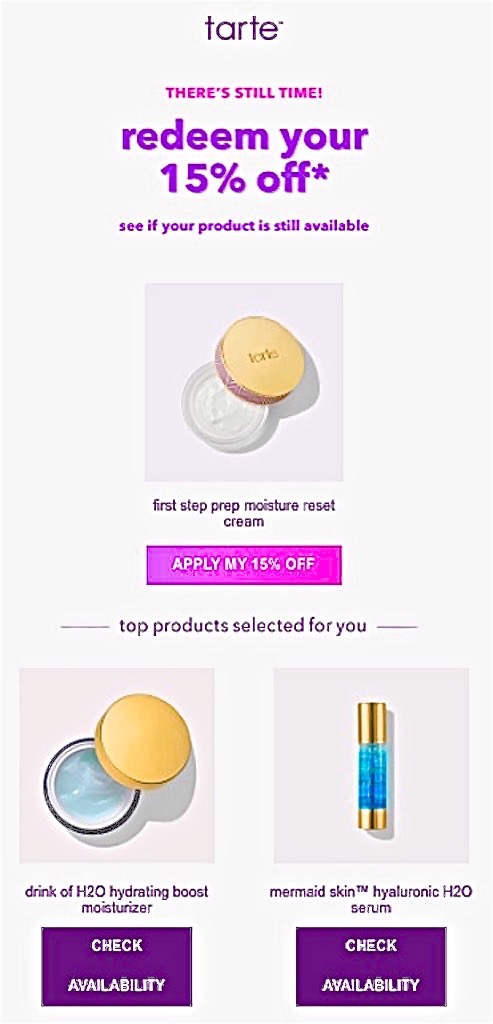The eCommerce industry has seen a dramatic boom in recent years, and there is no end in sight to the heights of which online sales may skyrocket. Just look at the rock solid eCommerce stats projecting that for 2021, online sales are expected to reach a minimum of $3.5 trillion — put that together with the fact that eCommerce sales accounted for 11.9% of all retail sales worldwide in 2018, and you can see why having a responsive marketing campaign is vital to growing your brand.
Let’s turn our attention to the leader of the pack: when it comes to illustrating the dynamic growth of the industry no eCommerce brand does better than Amazon. With global revenues at $108B and a growth rate of 19%, Amazon dominates eCommerce and overwhelmingly cliches 1st place among the Top 10 eCommerce Companies in the World 2018.
In order to send your brand into orbit in 2021, you need to kick off the new year by staying on the cutting edge by gaining access to the most relevant eCommerce marketing strategy case study. And, while you’re at it, why not add some new ideas into the mix? That’s what we are providing to you. Check out our strategic guide that will walk you through — step by step — everything you need to create your perfect eCommerce marketing strategy 2021 to make this year your brand’s best yet!
For convenience sake, we followed the same general outline that Google Analytics uses for User Acquisition. Let’s break that down for you:
1. Start by defining your persona(s)
First and foremost, in any marketing strategy, the most important step is to identify your ideal customer. Figuring out your target customer is not as overwhelming as it might seem at first. Thanks to marketing automation tools, you can easily analyze your current order data and combine that information with Google analytics. Follow these few tips to effortlessly define customer personas:
Define your ideal customer
Start by figuring out a rough idea or even create an eCommerce marketing strategy template of who your ideal customer is. Ask yourself: who do you want to attract to your eCommerce shop? You will most likely find that you end up with more than one customer persona. That’s ok. Take a closer look at what customers are buying which products, and possible motivation of sales (such as gift-giving, etc).
Analyze insights for customer demographics and behavior
Once you have some basic persona types down it’s time to look at insights gained from the data you have collected from your customer and contact database from your automated platform analytics reports and Google Analytics. Understanding the various demographics and patterns of traffic visiting your site is crucial to further refine your personas and helps you segment persona based on factors such as age, gender, income, location, and more. Also, this step allows you to analyze customer behaviors such as buying habits, interests, online activities, etc.
Send surveys
For an even further in-depth look at persona types, use an automated platform to go to the source itself by sending your customers questions via simple quick surveys. You’ll uncover more insights and ultimately build an even stronger persona.
Put it all together.
As soon as you have all of your information gathered, put it all together and create actionable insights for targeting your personas. Using a marketing automation platform makes the process simpler since it gathers the key data and offers segmentation capability to define your persona segments.

Audience segmentation by browsing history and interests
2. Build your 2021 eCommerce marketing strategy plan
Once you define your target customer, the next step in creating a successful responsive eCommerce marketing plan is to select the best marketing tactics to include in your marketing mix.
When it comes to understanding and targeting the right persona(s), smart online marketers fall back on the age-old, tried and tested 4Ps of marketing. That’s right, it’s time for Marketing 101! This oldie but goodie basic concept of identifying product, place, promotion, and the price is an awesome and very relevant marketing model when creating a top eCommerce marketing strategy.
A closer look at how the 4Ps apply to eCommerce marketing
Product:
A perk of selling online is that marketers have significantly more opportunities to provide in-depth product detail about their products. From accurate product descriptions and specifications to even creating HD videos and multi-angled photos to showcase the capabilities of a product, marketers can influence their customers.
Include recommendations, expert reviews, and links to related products to create a profitable atmosphere. This is the opportunity to present your products to your target audience in a way that most appeals to them.
Promotion:
In online selling, promotion (or in eCommerce, channels) play a key role. Freebies, BOGO deals, and discounts — now this is something everyone loves! And, there is no better place for marketers to provide customers with deals and offers. There is a range of promotional selling mechanics available such as recommendations, discount codes, loyalty discounts, offers, and more. Really, the possibilities are limitless to how creating the perfect online promotion can help boost your e-shop conversion rate.

The 4Ps: include offering discounts via promotions in your eCommerce Marketing Strategy
Place:
The Place is super, uber important. Why? Your customers are looking for a well-designed, easy to navigate website that provides quick and friendly service in a safe and secure environment, just as if it were a physical store. That’s why the set up of your online store is so important. This “P” is pretty cool – since your online store travels with your customers wherever they go and operates 24/7!
Price:
This is where offers such as free shipping and no-hassle returns come in handy. When we talk about price in relevance to your online marketing plan, remember that it’s really easy for your customers to price compare by simply navigating to another site. You need to be sure to offer them a deal that they can’t say no to.
3. Experiment with customer acquisition channels that suits your business model
Once you have your 4Ps in order, you can move on to the marketing tactics per Customer Acquisition channel, based on your Google Analytics panel. These are the channels you need to focus on and build:
Channel #1. Organic Traffic
It cannot be stressed enough that every eCommerce marketer needs to implement ways to drive organic traffic, so that when customers are searching the web for your products, they are able to find your e-shop and purchase from you. In fact, according to reports, 39% of the total global traffic comes from search, out of which, 35% is organic traffic.
Here are the latest Best Practices for driving organic traffic to help you develop a rockin eCommerce marketing strategy for 2021:
SEO for Categories and Products:
Optimizing your individual product pages not only makes it easy for your users and search engines to navigate to your website, but it also ensures that you are preventing your various individual product pages from competing with each other in terms of SEO. Now you understand why it’s important, but, where do you start? Don’t worry, we’ve got you covered. Read on to learn how you can create the best eCommerce marketing strategy…
Best Practice: Optimizing your category titles — keeping it simple
A key element in SEO for eCommerce is to be sure you don’t get over-creative with naming for your category pages. Instead, use descriptive names that are relevant and useful.
Best Practice: Keyword research and optimized content on category page
Perform keyword research to find the optimal keywords that target your eCommerce product category page. This way you are sure to improve your category page rank for specific terms that your customers search for when they are looking for your products.
Also, most importantly, when your customers are looking for your products, they are easily able to find what they are looking for. Hassle-free shopping is key.
Best Practice: Showcase your most popular selling products on your category page
A solid best practice that is sure to boost your conversions and links is by highlighting your most popular and best-selling products on your category product page.
Complete your product category pages by adding not only introductory content but also be sure to add optimized content in the form of a paragraph or two, including internal links to sub-categories as well.

Best Practice: Showcase your most popular selling products on your category page
Link building:
Along with high-quality content on your website, don’t underestimate the value of credible backlinks. They can help build your e-shop to have an authentic reputation, which will ultimately generate even more backlinks and continue to grow your online presence for your website. Here are some Best Practices to generate backlinks to your eCommerce store:
Best Practice: Start by exchanging links with your suppliers. Then focus on releasing good content.
Create shareable content that is well-researched and links to other valuable content that fits into a specific niche. For example, creating posts highlighting features listing your favorite automation tools helps you link to recognized web content, which also gives way for the sites of brands you mention to share your content and create a backlink.
Channel #2. Social Media
Because of its very nature, social media is a place where content goes viral. These channels, therefore, play a very important role in your word-of-mouth marketing. In fact, 74% of consumers rely on social media to guide their purchases.

Best Practice: Keep your posts short and to the point
Instagram Marketing:
Best Practice: Instagram influencer marketing
Instagram is nearly a $2 billion industry, and using influencer marketing is trending. This marketing tactic is the perfect way to get your brand to stand out from the crowd and reach your target audience with this seamless concept of allowing the influencer to sell your products for you. It’s becoming the preferred channel, rather than traditional advertising and making direct sales pitches from businesses to their customers. Of course, don’t forget to put some effort into your content to look as neat as possible since this is… Instagram after all!
Facebook Marketing:
Best Practice: Keep your posts short and to the point
Facebook posts under 40 characters receive 86% higher engagement than other posts. Create short and direct messaging to capture the attention of your target personas.
Best Practice: Drive business with contests
80 percent of marketers believe that contests and other forms of interactive content, such as videos or polls, attract more views than static posts. Since Facebook sees over 1.65 billion users every month, standing out from the crowd is a must. Try offering unique incentives such as contests to capture the imagination and attention of your customers!
Pinterest Marketing:
Best Practice: Distributing blog posts
According to Shopify, 90% of consumers say that Pinterest helps them in deciding the products that they want to purchase. Combine this with the fact that Pinterest is a huge driver of website traffic across all industries, and there you have it — the perfect channel to distribute your blog posts!
Best Practice: Using text on the main image
As you are gearing up to distribute your blog posts on Pinterest, don’t forget to adhere to this super important best practice! This means adding text on your main image, which includes using text on the image itself and writing a short description that highlights the benefits for the reader.
Snapchat Marketing:
Best Practice: Originality is everything!
This marketing channel is the perfect outlet to reach younger demographics, as it is dominated by users under 35-years-old. However, if you post anything but original content, you might as well not bother. Creative media that adds value to your brand is the way to go with Snapchat.
Channel #3. Email Marketing
Grow sales with email marketing, effortlessly. How? Create an eCommerce email marketing campaign using automation. Why bother? Email marketing campaigns outperform social media platforms such as Twitter and Facebook by generating 174% more conversions! Not to mention automation allows you to see more of an overall return despite a lower investment of time and resources.
With 49% percent of companies using some form of email marketing automation for enterprises, you don’t be left out. These platforms make it easy peasy to build an engaging relationship with your customers and grow sales. You only need to customize your email campaign to your brand, and automated platforms do the rest — even down to optimizing scheduling of sending the email! Here are some of the top eCommerce email marketing best practices you should follow.

Personalized campaign automation flow designed for every consumer journey.
Best Practice: Email automation to personalize emails
Accurately target your customers with personalization, not only by name, but by interest as well using segmentation. Something as simple as adding personalized subject lines to your emails means they are 26% more likely to be opened. Overall, by executing this best practice and implementing a segmented email marketing campaign, you can expect to skyrocket your business and achieve as much as a 760% increase in revenue!
Best Practice: Behavioral Trigger Emails
Another automated feature is using behavioral trigger emails. This eCommerce marketing tactic is proven to drive in 152% higher open rates for emails, compared with traditional emails.
Best Practice: Send Abandoned Cart Emails
Sending abandoned cart emails will help you recover 15% of revenue that would have otherwise lost when shoppers abandon products in their carts!

Best Practice: Send Abandoned Cart Emails
Channel #4. Referral Traffic
When it comes to Ecommerce conversion rates by traffic source, referral traffic is by far the best performer. In fact referral traffic outperforms other channels’ conversion rates by bringing in 5.44%. So, what exactly is referral traffic? This channel of traffic consists of visitors who find your website through external links. Now, let’s look at some eCommerce best practices that can help you score big in referral traffic:
Best Practice: Create quality content to attract valuable link building to credible sources
Focus on building elements such as good content, in order to effortlessly create an environment where you can acquire links from credible 3rd party sources.
Best Practice: Targeted advertorials on important brand keywords
Bidding on your own brand keywords to dominate your domain by appearing in both the organic and paid ads columns creates an even more trustworthy reputation for your brand, as you appear to be the authority on your products or services.
Channel #5. Paid Channel
Paid channels are also commonly referred to as search engine marketing (SEM) or pay-per-click (PPC). You have many different paid channels to choose from, however, the two heavy-hitters are Facebook Ads and Google Adwords. In fact, Facebook videos out-perform YouTube by 478%!
These channels are valuable because they allow eCommerce marketers to quickly acquire a variety of customers effectively and quickly. Try these best practices on for size:
Facebook/Google Ads:
Best Practice: Run remarketing ads on proven segments
Since the cost of Facebook advertising continuously rises, the best way to keep your customer acquisitions costs as low as possible is via segmentation. Nailing your Facebook ads segmentation strategy on your will help you protect your profit margins.
Best Practice: Invest in video ads
It’s super simple to create relevant content to target specific audiences with Facebook video. In 2017, facebook videos outperformed text and static images by 1200% and drove an astonishing 135% more organic traffic!
Best Practice: Invest in multiple ad variations and A/B testing
Change up your ads to test variables, one at a time. An example is changing your target age demographic, but keep your location the same. That way you can see what’s really working to drive more views and conversations. It’s actually quite simple using a number of tools that allow eCommerce marketers to perform A/B significance tests. This is a must when launching a new campaign to avoid costly errors by using the wrong video ad variation, etc.
Dynamic Remarketing:
Best Practice: Dynamic Search Ads (DSA) and Remarketing Lists for Search Ads (RLSA)
Using these two campaign subtypes from Google Ads means creating and then targeting your site categories based on how your site is indexed couldn’t be any easier. All you need to do is provide Google Ads with your homepage, and Google does the rest to help you effortlessly reach your users via DSA!
Combine the RLSA campaign, and you’ve got yourself a hybrid campaign, where eCommerce marketers are able to focus on insights provided by your audience lists in your search campaigns! Then, you can remarket and bid on broader keywords or other keywords that normally you wouldn’t bid on for your paid channel.
Channel #6. Direct Traffic
Direct traffic accounts for over 50% of traffic for the leading e-commerce websites. Since big brands have better recognition, this isn’t surprising. However, any eCommerce shop can increase its direct traffic by adding the following elements to your eCommerce strategy:
Best Practice: Create loyalty programs
Designing a customer loyalty program helps to drive the chances of repeat visitors, therefore driving up your site’s direct traffic. Whether you use a simple points-based system, offer coupons for next order, run a monthly contest, or use a tier system to reward initial loyalty and encourage more purchases, you’ll be sure to boost your traffic and sales.
Best Practice: Use marketing automation
Marketing automation for loyalty programs is a must. This way, you’ll be able to focus your campaign on personalization. Customers love to receive offers of gifts and reward programs, however, these offers need to be tailored to their shopping persona!
Ready. Set. Blast off!
With the right tools and resources, it is totally feasible to effortlessly create a responsive eCommerce marketing strategy. And, the fact is, having a tried and tested marketing plan in place for 2021 is vital to the growth and success of your eCommerce brand. Try out some of our recommended best practices and eCommerce marketing strategy examples above when designing your marketing plan this year and buckle-up — when you launch your marketing plan your brand will climb to new heights — maybe even another galaxy! Bon voyage!





